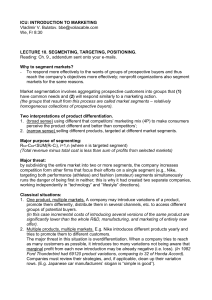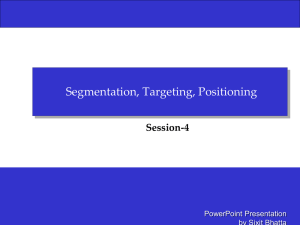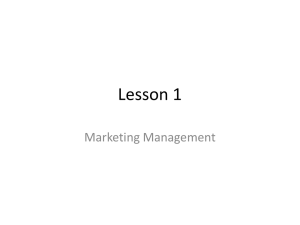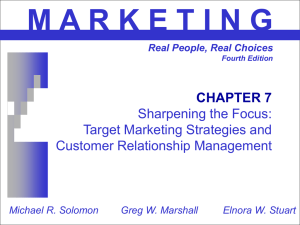Segmentation, Target Marketing and Positioning ( STP) MINTEK
advertisement
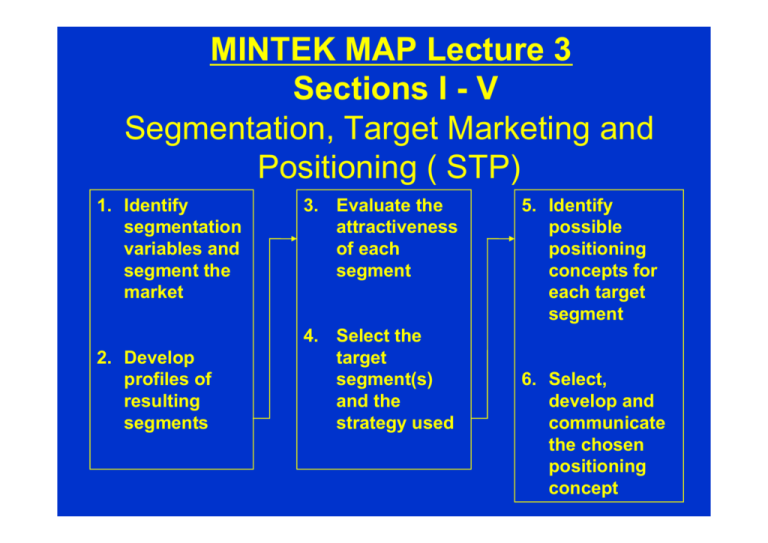
MINTEK MAP Lecture 3 Sections I - V Segmentation, Target Marketing and Positioning ( STP) 1. Identify segmentation variables and segment the market 2. Develop profiles of resulting segments 3. Evaluate the attractiveness of each segment 4. Select the target segment(s) and the strategy used 5. Identify possible positioning concepts for each target segment 6. Select, develop and communicate the chosen positioning concept I. MARKET SEGMENTATION 1. Process of dividing the total market for a good or service into groups of similar consumers and Selecting the most appropriate group(s) for the firm to serve. This then becomes the TARGET MARKET. 2. The Segmentation Process leading to identification of target markets together with the 4P’s guides the organisation’s marketing strategy. 3. Marketing Strategy = STP+MM I. AGGREGATION vs SEGMENTATION 3.1 MARKET AGGREGATION is the strategy whereby an organisation treats its total market as a unit eg. Henry Ford’s Black Model T’s and until the 1950’s, Coke. Later Levi jeans in the 1980’s and even SA Banks. The organisation then develops a single marketing mix to reach AS MANY customers as possible in this aggregate market eg. staple items, convenience goods, salt, sugar, petrol (see undifferentiated target market strategy). 3.2 MARKET SEGMENTATION is composed of many smaller segments with similar needs based on a segmented market. The goal is to divide the market in such a way that EACH SEGMENT RESPONDS TO A DIFFERENT / UNIQUE MARKETING MIX. I. BASES FOR MARKET SEGMENTATION WE CAN USE DIFFERENT BASES FOR CONSUMER SEGMENTATION: Demographic, Geographic, Lifestyle and Usage Behaviour 1. Geographic a) Metropolitan b) Rural c) Local Communities d) Density e) Size of City or Town 2. Demographic a) Age b) Gender c) Family Life Cycle – where is the customer in this? d) Income / Occupation e) Marital status f ) Ethnic/Religious background g) Level of Education h) LSM groupings 1-10 Laurence Beder & Associates I. BASES FOR MARKET SEGMENTATION Demographic, Geographic, Lifestyle and Usage Behaviour 3. Lifestyle / Psychographic a) Personality: Conservative, exciting, trendy, outgoing, shy, withdrawn, amicable, underdog b) Social Class: Lower, middle, upper c) Opinions: Easily led, opinionated, leader, business, economics, education d) Activities and interests: Sports, TV, entertainment, drinking, partying, career, family, home, recreation, hobbies, shopping, religion, community involvement e) Attitudes and beliefs: Environmentalists, security conscious, realists 4. Customers & Product Usage Behaviour a) Loyalty: none, medium, high b) User status: none, potential, regular c) Usage rate: light, heavy, medium d) Benefit sought: economy, convenience, prestige e) Purchase occasion: regular or special Laurence Beder & Associates II. Geographic Segmentation Regional Distribution of Population is important to marketers because people within a region generally tend to share the same values, attitudes and style preferences. Climate and social custom also have an effect. eg. Air conditioners, ice cream, warm clothing. Firms can alter their marketing mix to adapt to these regional differences. Urban, Suburban & Rural Distribution segments their marketing on the basis of city size or population concentration eg. Community newspapers have local content and advertisements to reach these areas. Unilever gives out Omo samples in rural areas to teach people how to use washing powder rather than laundry soap and Teba Bank services the Rural poor II. Demographic Segmentation (because info is available and related to consumer’s behaviour) AGE: wants/needs change as we go through life eg. Rennies, Vitaforce/Bettaway vitamins EDUCATION : Standard 6-8, Matric, Tertiary education, Postgraduate GENDER: Marketers of products such as clothing, shoes, personal care, cars, magazines & credit cards. eg. Carling Black Label,CK One, Winfield. OCCUPATION: Technical, managerial, sales, non qualified, professional, white collar, blue collar, home executives FAMILY LIFE CYCLE: bachelor, young married, single parent, divorced and alone, middle age married, full nest, empty nest, older single – Who makes the decisions? STATUS/SOCIAL CLASS: includes level of education, type of occupation and the type of neighbourhood person lives in. Also ethnic groups. INCOME: people must have money to spend; their spending patterns should be analysed at different income levels eg. Ackermans, Clicks, Stuttafords II. Psychographic Segmentation Involves breaking up the market in terms of how a person thinks, feels and behaves. i) PERSONALITY TRAITS In-born traits that influence buying behaviour through attitudes and habits, eg. You’re the Fire, Axe deodorant and Flake ii) LIFESTYLE Divides people into groups according to the way they spend their time, their belief systems and socio-economic issues such as income and education are eg. conservative vs liberal, outdoor vs indoor types; impacts on interest and activities. This also affects brand loyalty. eg. cigarettes, cars, sports fashions etc. iii) iv) v) VALUES AND MOTIVES ACTIVITIES, OPINIONS AND INTERESTS GEODEMOGRAPHIC II. Product Behavioural/Benefit/Usage Segmentation The process of grouping customers into market segments according to the benefits they seek from a product i) USAGE RATE AND BRAND LOYALTY (Heavy, medium, light or non-users) Divides market by amount bought or consumed. Normally we are interested in heavy users but sometimes target non or light users eg. Windhoek Lite. Heavy users still account for 80-90% of total purchase and are normally extremely brand loyal. ii) BENEFITS DESIRED from a product not just features ie. identify separate benefits consumers desire when seeking a product eg. Benefits from each different-Nokia cellphone eg Music, GPS, Camera iii) PURCHASE OCCASIONS -Valentines Day, Mothers Day II. MARKET SEGMENTATION 1. Pre-requisites for Effective Communication Segment A Segment B Segment C Segment D Ask whether the segment/s chosen is: - Large enough - Accessible / reachable via communication - Potentially profitable, the Small Business Owner will decide which of these segments to enter If the answer yes to most, you might want to enter that segment Laurence Beder & Associates II. MARKET SEGMENTATION 2. Choosing a segment or segments to make into your business’s target market/s: A C b D The Company has decided to enter segments A, C & D. These three segments become the Business’s TARGET MARKETS. Segment B is still a segment but not a target market. You might pursue this segment later. Laurence Beder & Associates II. Segmenting the Business / Organisational Market Aiming your product or service to organisations /(B2B) is different than to consumers / customers. Five factors for Segmenting organisational markets are: a) Geographic – Region (Gauteng, EC) and location City, Urban, Rural etc. b) Organisational Demographics – Number of employees(1-19, 20-99) and size of business based on sales ie less than R1m, R1m-R10m) c) Organisational Type - Manufacturing, service, institutional, government Type of goods eg. raw materials, components, accessories, supplies, services d) Usage rate – heavy user, medium user, light user e) Decision Maker – Demographic / Psychographic profile – can you target the decision maker effectively? More emphasis is placed on what the profile of the business to be targeted is!!! II. Bases for Segmenting Industrial Markets Demographic On which industries should we focus? What size company must we target? Which geographical areas must we target? How long has the company been in business? Does the company have one/multiple establishments? Is it a local/national/international company? Operating Variables On what technologies should we focus? On what user types should we focus (heavy, medium, light, non-users)? Should we focus on customers requiring many/few ` services? II. Bases for Segmenting Industrial Markets Purchasing Approaches How centralised/decentralised is the purchasing function – very NB? Should we focus on companies that seek quality/service/lower price ? Should we focus on companies with which we have strong links or should we go after the most desirable ones? Should we concentrate on organisations that prefer leasing/service contracts/systems purchases? Should we focus on businesses that are financial/ marketing/production/engineering dominated? Is it a local/national/international company? II. Bases for Segmenting Industrial Markets Situational Factors (80/20 rule applies) Should we focus on customers who require periodic quick delivery or should we focus on those that require regular, steady delivery? Should we focus on special application of our product or on all applications? Should we focus on small/medium/large orders? Personal Characteristics Should we focus on companies which have values similar to ours? Should we concentrate on organisations which are risk takers or risk avoiders? Should we focus on companies that show high loyalty towards their suppliers? Also remember the (SIC) Standard International Classification II. Bases for Segmenting Industrial Markets i) As in the case of consumer market, the B2B marketer must compile a description of the NEEDS CHARACTERISTICS and demands of the various market segments, based on the above dimensions. ii) The following is a guideline: List major industrial segments Prepare a profile of each segment’s characteristics Gauge needs of segment from this profile Design product and service specifications from needs III. Living Standard Measures (LSMs 1-10) A set of descriptors based on more than one variable – is a more powerful segmentation tool than any single variable. Designed to profile the market into relatively homogenous groups. (People with the same needs) Is a unique means of segmenting the SA Market. It cuts across race, income or education and instead groups people according to their living standards using the following: 1. Degree of urbanisation. 2. ownership of durable goods. 3. access to services yields a composite measure of social class. Previously LSM 1-8 now LSM 1-10. SAARF LSM® Groups Penetration Ave HH Income 2007B 2008A 2009A 2007B 2008A 2009A SU-LSM 1 4.1 3.4 3.5 R 1,028.15 R 1,080.45 1269 SU-LSM 2 9.8 8.7 7.3 R 1,275.25 R 1,401.29 1475 SU-LSM 3 10.8 9.4 7.8 R 1,638.06 R 1,794.81 2267 SU-LSM 4 13.8 14.6 14.2 R 2,140.55 R 2,535.68 2424 SU-LSM 5 14.5 15.5 15.2 R 2,952.07 R 3,122.33 3462 SU-LSM 6 17.3 17.9 19.5 R 5,096.28 R 5,386.00 5755 SU-LSM 7 9.3 9.4 10.2 R 8,320.26 R 8,667.33 9638 SU-LSM 8 6.7 6.9 7.6 R 11,227.27 R 12,336.69 13002 SU-LSM 9 7.6 8.1 8.5 R 14,740.73 R 16,296.05 17648 SU-LSM 10 6.1 6.1 6.3 R 20,902.03 R 23,053.57 15179 Significant increase on 2008A Significant decrease on 2008A III. South Africa’s 10 LSM Living Standard Measure Groups LSM 1: RURAL DWELLERS • Average income R879 a month (mostly social grants). •Traditional huts. •Very high unemployment – 83%. •High illiteracy – one in five has no formal schooling. •No tap water. •No fridge, and no insurance. •Biggest representation in KZ Natal and E Cape. SA’s 10 LSM’s LSM 2: FARM WORKER LEVEL 91% live in rural areas – one third in traditional huts – with some in formal settlements. • Average income R1068 a month • Most employed are farm workers and labourers. •One third have access to running water – mostly outside. • First level to have TV’s at 30% and cell phones, at 13% SA’s 10 LSM’s LSM 3: MATCHBOX HOUSE/ INFORMAL SETTLER LEVEL • Over a third live in urban areas. • Mostly “matchbox housing” and informal settlements. • Average income R1408 a month. • Almost half own a TV set and a fridge SA’s 10 LSM’s LSM 4 :THE URBAN POOR • High number of backyard and poor township dwellers. • Average income R1774 a month. • Highest number live in Gauteng. • Three-quarters own a TV set. SA’s 10 LSM’s LSM 5: “SOMETHING TO LOSE” GROUP • First level to have significant levels of insurance. • Average income R2427 a month. • Almost two-thirds employed. • Almost 90% have a TV set; a VCR and/or a fridge. •Microwaves appear, and almost half have at least a kitchen sink. • Rate of clothing purchases close to middle-class levels. SA’s 10 LSM’s LSM 6: FOLKS IN THE FLATS • Very urban group, with the highest level of flat living. • Average income around R4000 a month. • Virtually everyone has a TV, a fridge, and entertainment centre. • Employment includes “professional/ technical”, but service and clerical/ sales is still high. • Many have washing machines and freezers. • Hiring of DVD’s and videos is common. SA’s 10 LSM’s LSM 7: TOEHOLD IN THE MIDDLE-CLASSES • High number in small houses and cluster homes. • Average income R6445 a month. • Some can afford domestic help. • Most have cell phones. • Most have ATM cards, few have a credit card. • A third own a vehicle. SA’s 10 LSM’s LSM 8: TOWNHOUSE AND RETIREMENT GENERATION • Highest level of townhouse dwelling. • Older age profile than middle LSMs. • Average income R8471 a month. • A quarter own PC and DVD player. • Job types include administrative/ managerial. SA’s 10 LSM’s LSM 9: HOUSEWIVES AND HOLIDAY SPENDERS • Highest level of “housewives”, most have domestic help. • Average income R11560. • Group unusually dominated by males. • English and Afrikaans dominate as home languages. • 100% ownership of “everyday appliances”. • Many spend on timeshare holidays and travel. SA’s 10 LSM’s LSM 10: SWIMMING POOLS, SELF-EMPLOYMENT AND SUBURBIA: WELCOME TO EASY STREET • Medical insurance , stock exchange investment and home loans peak. • Most have DSTV; and pay for private security services. • Swimming-pool ownership almost 300% over LSM 9, and almost everyone has a PC. • Most are English-speaking. IV. Target Market Strategies 1. Accompanied by PRODUCT DIFFERENTIATION creating impression that a firms product is better than the competitor’s brands. Uses packaging changes, non-price competition and perceptual approach. Changes superficial feature of product or uses promotional approach that features a differentiating benefit. Eg: - Caltex Vortex, Shell Super V, versus Sasol Duel fuel Cerebos Salt versus No Name Brand salt Aquafresh versus Colgate Total toothpaste Disprin CV 300 and Asprin IV. Target Market Strategies 2. Single-Segment Concentration (Rifle Approach) Involves selecting as the target market ONE homogeneous segment from within the total market. ONE HIGHLY SPECIALISED MARKETING MIX is developed to reach single segment. Strategy is going after a large share in small market eg. originally Mercedes Benz, today only Rolls Royce, Ferrari and Porsche (class appeal) in South Africa. Penetrate one small market in depth and acquire reputation as a specialist. As long as segment is small, unlikely entrance by competitors, but downside is all eggs in one basket cannot expand easily within another segment eg. Mont Blanc pens competing with Parker pens. Harley versus Kawasaki. Some Operating economies can also apply. IV. Target Market Strategies 3. Multiple-Segment Strategy A firm chooses to serve two or more well-defined market segments and develop a distinct marketing mix for each. Volkswagen / Audi develops separate marketing programmes for each conceivable market segment, ranging from the Citi Golf to the Audi A8 and Southern Sun with its Intercontinental Hotels and Resorts, Crowne Plaza, Holiday Inn, Garden Courts, Formula 1 etc. Please note some firms use different promotional appeals, rather than different marketing mixes. Market segmentation can also be accomplished without actually changing product but with changing other 3P’s eg. Developing marketing courses for different segments. For undergraduate programme, in-house programmes and this MAP programme. IV. Target Market Strategies 3. Multiple-Segment Strategy Produces greater sales volumes, higher profits, larger market share with the diversified product lines but also creates increased costs, eg. product modification, production and promotion costs. eg. SAB Beers - Can cause Cannibilisation Useful for products facing seasonal demand - eg. “Green Season in the Cape”. Undifferentiated Targeting Advantages • Mass marketing ensures lower costs due to economies of scale Disadvantages • Susceptible to competition eg IBM • Less than optimal need satisfaction • Slow adaptation Single Segment (Niche) Targeting Advantages • Specialisation, better service to customers, need satisfaction • Do not compete on price • Lower total cost • Higher profit per unit • Quick adaptation • Better positioning Disadvantages • All eggs in the same basket • Exposed to environmental changes • Exposed to changes in demand • Vulnerable to competitive attack Multiple Segment Target Market strategy Advantages • Potentially greater sales volume • Higher profits • Larger market share • Economies of scale in: manufacturing marketing Disadvantages: Higher costs • Production design costs • Production costs • Promotion costs • Inventory costs • Market research costs • Management costs • Cannibalisation V. Develop a Positioning Strategy A. What is it? Positioning is the act of DESIGNING THE COMPANY’S PRODUCT AND MARKETING MIX TO FIT A GIVEN PLACE IN THE CONSUMER’S MIND Once a target market has been selected the marketing manager needs to develop a DIFFERENTIATING AND POSITIONING STRATEGY for that target market eg. Red Bull vs Play vs V vs 911 Differentiation is the act of designing a set of meaningful differences to distinguish the company’s offer from the competitor’s offers. THE OBJECTIVE IS TO CREATE A SUSTAINABLE COMPETITIVE ADVANTAGE through bases for differentiation: a. Product Differentiation – Performance, Durability, reliability b. Services – installation, consulting, training, repairs c. Personnel – competence, , responsiveness, communication d. Image – jet set, symbol, on your side, innovative, discount Positioning Map - Competitive Position (Motorcars) Has a touch of class A car I’d be proud to own Distinctive-looking Spiritperformance Conservative Sporty-looking looking Appeals to older people Fun to drive Appeals to young people Very practical Gives good petrol consumption Affordable V. Develop a Positioning Strategy B. Positioning Positioning involves the following steps: 1. Company must identify differences that may be established in relation to competition. 2. Select the most important differences. 3. Communicate or signal to the target market how the company differs from its competition. V. Develop a Positioning Strategy C. Methodsto position products In general, various positioning methods can be distinguished. 1. Attribute Positioning / Customer Benefits The enterprise positions itself in terms of one or more outstanding attributes or benefits. eg. ETV - free television. Sage - first name in Unit Trusts. 2. Product Benefit Positioning This positioning method emphasises the unique benefits that the enterprise or product offers eg. Gillette Fusion Power Razor and blades. Promise an even closer shave. V. Develop a Positioning Strategy C. 3. Quality / Price Positioning The enterprise may claim that its product is of exceptional quality, or has the lowest price. Stuttafords vs Pep Stores, Chivas Regal vs 100 Pipers. 4. Use / Application Positioning An enterprise can position itself on its market offering in terms of the product use or application possibility. Nike describes one of its shoes as the best for running, another best for X training, another best for soccer. V. Develop a Positioning Strategy C. 5. User Positioning The enterprise may position its products with users in mind, using models or personalities. Influences image of product by association eg. Halle Berry - Revlon girl, Winston & Winston Lights, Marlboro & Camel Man. 6. Product Class Positioning Some marketers need to make critical positioning decisions that involve what product class or category the product falls in eg. Canderel sweetner against sugar, Red Bull against soft drinks, Energade, Hansa - leader in product class. V. Develop a Positioning Strategy 7. Competitor Positioning Some market offerings can best be positioned against competitive offerings. BMW would find it useful to position their cars directly against those of Mercedes Benz, as well as Audi, Volvo, SAAB etc. Also car hire. Are you better than your competitor? 8. Origin Positioning eg. Scotch Whiskey, Audi, Perrier/Evian water, Boerewors V. Develop a Positioning Strategy D. Positioning Alternatives – Three options: 1. Entrench eg. Avis 2. Find a new position eg. Cida City Campus 3. Reposition eg. BP, Toyota, MTN, Pringle, Pick n Pay




